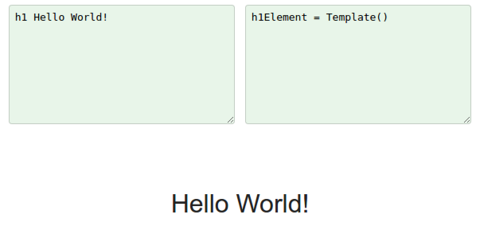jadelet-et
v0.8.0-pre.11
Published
Lightweight, elegant HTML templates
Downloads
4
Readme
Jadelet
Pure and simple clientside templates
Jadelet is the cleanest and simplest way to describe your templates. It is a breeze to learn. Jadelet attributes correspond directly with HTML attributes. If you know HTML then you already know Jadelet.
Other libraries and frameworks put up barriers between you and the DOM. Like a dutiful servant, Jadelet brings the power of the DOM into your hands.
Jadelet is the smallest of all clientside templating libraries (< 2.5kb). But don't let its size fool you: it contains tremendous power.
Jadelet is free, MIT licensed, open source, non-GMO, and production ready.
Examples
Header
h1= @titleHeaderTemplate = require "./header"
headerElement = HeaderTemplate
title: "Hello world"Button
button(click=@sayHey)ButtonTemplate = require "./button"
buttonElement = ButtonTemplate
sayHey: ->
alert "heyy"See more in the Example Playground
Getting Started
Install Jadelet:
npm install jadeletCompile your templates:
node_modules/.bin/jadelet -d templatesThis will create a .js version of each template in your templates directory.
To use the templates in a Node.js style project built with browserify you can require them normally.
// main.js
mainTemplate = require("./templates/main");
document.body.appendChild(mainTemplate(data));Now use browserify to build the file you'll serve on your page.
browserify main.js > build.jsRoad to 1.0
- [x] Still under 2.5kb
- [x] Don't Leak Resources
- [x] Style Attributes
- [x] Filters
- [x] Changelog
- [x] Example Playground
- [x] | for text content
- [x] Remove :filters
- [x] Updated README.md
- [ ] jadelet.com
- [ ] Documentation
- [ ] Getting Started Guide
FAQ
Ewww... CoffeeScript
That's not a question.
Is Jadelet safe from XSS?
Yes. Jadelet uses native DOM APIs to write string output as text nodes.
How do I use Jadelet to render HTML Elements?
Jadelet knows the type of objects it renders. When you pass an HTMLElement it will insert it into the DOM.
.content
h1 My Canvas
= @canvasTemplate
canvas: document.createElement('canvas')Is it production ready?
Yes, we're currently using Jadelet to power glitch.com. (Though we still have a 'Beta' sticker up... ¯\_(ツ)_/¯)
Is it performant?
Yes! And because it's just DOM stuff you can easily drop down to the native DOM APIs for the pieces of your app that need special optimization.
How can I contribute?
Open some issues, open some pull requests, let's talk it out :)
History
Jadelet was inspired by Haml and Jade.
Gotchas
Templates must have only one root element, they will fail with multiple.
Good:
.root
.one
.twoOopsies:
.one
.twoCLI
Command line interface for compiling templates.
Usage
Jadelet in, JavaScript out.
jadelet < template.jadelet > output.js
echo "h1#title= @title" | jadeletOptions
-d, --directory [directory] Compile all .jadelet files in the given directory.
jadelet -d templates--encoding [encoding] Encoding of files being read from --directory (default 'utf-8')
--exports, -e [name] Export compiled template as (default 'module.exports')
--extension [ext] Extension to compile when compiling files from a directory. Default is jade(let)? so it should pick up both .jade and .jadelet files.
--runtime, -r [runtime_name] Specifies the name of the globally available Jadelet runtime (default is 'require("jadelet")').
jadelet -r "Jadelet" < template.jadelet > output.js--ast, -a Output a JSON AST instead of the JavaScript template function. Useful for debugging or for using the Jadelet DSL as a frontend for other renderer backends like Mithril or React. Until 1.0 this isn't guaranteed to be a stable format.

